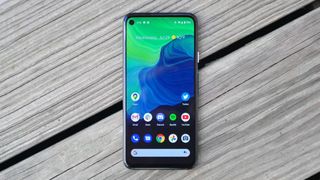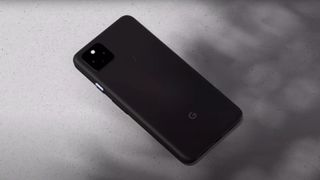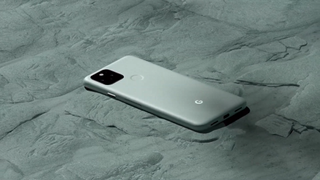Pixel 5 vs. Pixel 4a 5G vs. Pixel 4a: Which Pixel should you buy?
Google’s 2020 Pixel lineup is easily the most confusing that the company has presented to consumers. The visual similarities between the Pixel 4a, Pixel 4a 5G and Pixel 5 coupled with quite a few overlapping specs make it difficult to tell them apart despite the $350 range in their pricing.
Never fear though, our Pixel buying guide is going to walk you through all of the similarities and differences between these three devices to help you find the right one for you.
2020 Pixel models compared
| Pixel 5 | Pixel 4a 5G | Pixel 4a | |
| Starting Price | $699 | $499 | $349 |
| Screen | 6-inch Flexible OLED FHD+ (1080 x 2340) | 6.2-inch OLED FHD+ (1080 x 2340) | 5.8-inch OLED FHD+ (1080 x 2340) |
| Processor | Qualcomm Snapdragon 765G | Qualcomm Snapdragon 765G | Qualcomm Snapdragon 730G |
| RAM | 8GB LPDDR4x | 6GB LPDDR4x | 6GB |
| Storage | 128GB | 128GB | 128GB |
| Cameras (Rear / Front) | 12.2MP f/1.7, 16MP f/2.2 ultrawide / 8MP f2.0 | 12.2MP f/1.7, 16MP f/2.2 ultrawide / 8MP f2.0 | 12.2MP f/1.7 / 8MP f/2.0 |
| Video | 4K up to 60fps, 1080p up to 240fps | 4K up to 60fps, 1080p up to 240fps | 4k up to 30 fps, 1080p up to 120fps |
| Colors | Just Black or Sorta Sage | Just Black or Clearly White | Just Black |
| 5G support | Yes | Yes | No |
| Battery | 4,080 mAh | 3,885 mAh | 3,140 mAh |
| Dimensions | 5.7 x 2.8 x 0.31 inches | 6.1 x 2.9 x 0.32 inches | 5.7 x 2.7 x 0.32 inches |
| Weight | 5.33 ounces | 5.93 ounces | 5.04 ounces |
2020 Pixels common features
While there are some notable differences that we will address, all three of the smartphones in the Pixel lineup this year have quite a bit in common. As you would expect, all three smartphones run Android 11, the latest version of the Android operating system and will receive major OS support for at least three years.
Given the price disparity in these devices, there is a somewhat surprising number of overlapping hardware features as well. Each device comes with 128GB of storage and while it would be nice to have the option to go higher, it should be enough for most users with Google’s software helping you to manage your storage with Google Photos backups to the cloud and Files eliminating duplicate and unused files.
While the display sizes vary, the technology and resolution of the displays do not. All of the 2020 Pixel devices use an OLED panel with a 2340 x 1080 FHD+ resolution.
The primary camera lens for all three smartphones is also identical with a 12.2-megapixel f/1.7 with optical image stabilization and dual-pixel autofocus. This no doubt allowed Google’s camera team to really eke every last bit of performance out of this lens and sensor, so expect similar spectacular results across all three.
While the materials used for each device are distinct, the overall design is quite similar with a hole-punch 8MP front-facing camera in the upper-left corner of the screen and rounded corners with a minimal bezel. Turning to the back the fingerprint reader is found in the upper-middle of each smartphone with the square camera array in the upper-left.
Pixel 4a
The Pixel 4a was released back in August, and at just $349 it’s the cheapest Pixel ever and was incredibly well-received by reviewers. It shares a number of features with its more expensive siblings including an OLED display, 128GB of storage, its primary camera and an appealing if simple design.
As is commonly the case for Pixel devices, the camera is an amazing performer, particularly considering the cost of this device. In photo comparisons against the $399 iPhone SE, our sister site Tom’s Guide, found that the Pixel 4a was superior in every single example. While it lacks the multiple lenses and some high-end video capture of more expensive phones, it delivers class-leading photos.
The Pixel 4a features both a USB Type-C port as well as the increasingly rare 3.5mm headphone jack for those that haven’t adopted wireless headphones yet.
Battery life is one area that could have used a little improvement and notably did see a significant bump in the Pixel 4a 5G and Pixel 5, which also add 5G, something that the Pixel 4a lacks.
Best for: If you aren’t looking to spend more than $400 on your smartphone, the Pixel 4a is a simple and excellent answer. It delivers two things that are basically non-existent in other affordable Android smartphones, fast and reliable software updates and a first-rate camera experience.
Pixel 4a 5G
While it shares a name with the Pixel 4a, it has far more in common with the Pixel 5 and slots in between the two at $499. It is actually the largest of the three devices with a 6.2-inch display, not exactly Galaxy Note 20 Ultra territory, but it should be plenty for large phone fans.
From a design standpoint, the Pixel 4a 5G basically looks like a supersized Pixel 4a, retaining the same plastic build and general outline. It also hangs on to the 3.5mm headphone jack of the Pixel 4a. Those outward looks can be deceiving though as there are quite a few upgrades on the inside.
The inclusion of 5G is the most obvious and that comes with the upgraded Snapdragon 765G processor, which matches the Pixel 5. The Pixel 4a 5G also picks up an extra camera on the back, a 16MP ultra-wide lens that will allow you to capture landscapes or group photos when there isn’t a lot of room to work with.
The larger display warranted a much larger battery at 3,885 mAH, that’s a 745 mAH bump up from the Pixel 4a and should yield a few hours of additional battery life for the Pixel 4a 5G.
Best for: If you want the biggest screen that you can get in a Pixel along with the most powerful performance, the middle option is going to be just right for you. The Pixel 4a 5G is $200 less than the Pixel 5 and delivers a very similar overall package with just a few features cut to bring it in under $500.
Pixel 5
The Pixel 5 does not compete with the top-end flagships this year in many regards. However, that has never really been what the Pixel line was about and Google has simply embraced that this year. At $699, it isn’t a cheap smartphone and when compared to the Pixel 4a and Pixel 4a 5G you can see some of the niceties that the extra money earns you.
The 6-inch display with a 90Hz refresh rate is one of the more notable upgrades. Again, it’s not the 120Hz that we are seeing in other flagships, but it’s a discernible improvement from the 60Hz found in the other Pixels. The Pixel 5 also has a far superior contrast ratio at over one million to one, this should boost the HDR performance for content consumption.
From a durability standpoint the Pixel 5 is the easy winner among these devices with IP68 water resistance and an aluminum back and frame. Using a unique resin process, it also manages to offer wireless charging and reverse wireless charging despite the metal build.
While it shares the same Snapdragon 765G processor as the Pixel 4a 5G, it should deliver superior performance, particularly for multitasking, thanks to 8GB of RAM compared to the 6GB found in the other Pixels.
Best for: If you are looking for the best that Google has to offer there is no question that it is the Pixel 5. While there is some question as to how much of an upgrade it is from last year’s Pixel 4, this is a fantastic upgrade for users coming from a Pixel 3. The 90Hz display, 5G and wireless charging support make this the most future-proofed of Google’s 2020 Pixel lineup.








